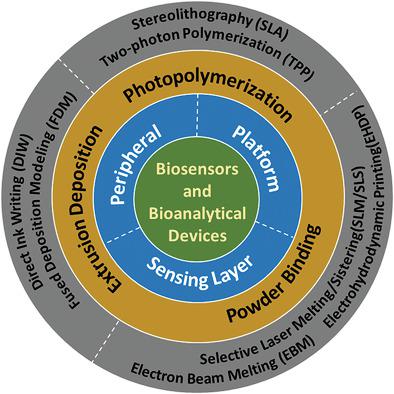当前位置:
X-MOL 学术
›
Adv. Mater. Technol.
›
论文详情
Our official English website, www.x-mol.net, welcomes your
feedback! (Note: you will need to create a separate account there.)
Emerging Applications of Additive Manufacturing in Biosensors and Bioanalytical Devices
Advanced Materials Technologies ( IF 6.4 ) Pub Date : 2020-06-03 , DOI: 10.1002/admt.202000171 Xiaofan Ruan 1 , Yijia Wang 1 , Nan Cheng 1 , Xiangheng Niu 1 , Yu‐Chung Chang 1 , Lei Li 1 , Dan Du 1 , Yuehe Lin 1
Advanced Materials Technologies ( IF 6.4 ) Pub Date : 2020-06-03 , DOI: 10.1002/admt.202000171 Xiaofan Ruan 1 , Yijia Wang 1 , Nan Cheng 1 , Xiangheng Niu 1 , Yu‐Chung Chang 1 , Lei Li 1 , Dan Du 1 , Yuehe Lin 1
Affiliation

|
The progress of additive manufacturing (AM), known as 3D‐printing, has initiated a revolution in the new generation of biosensors and bioanalytical devices in recent years. The advancement in the resolution of AM has enabled the microfabrication of the architectures of electrodes and sensing layers for high‐performance sensing. Diversiform printable materials, including biocompatible materials, polymers, various gels and metals, have enormously broadened the horizon in sensors and analytical devices for both research and commercial purposes. The considerable shortening of time and cost in sensor prototyping and fabrication has been reported and various highly customizable biosensing platforms and devices are under development. Herein, the most recent studies on the applications of AM in biosensors and bioanalytical devices are summarized with the aim to provide a panorama of emerging 3D‐printing strategies for sensor design and bioanalytical device fabrication.
中文翻译:

增材制造在生物传感器和生物分析设备中的新兴应用
增材制造(AM)的进步(称为3D打印)近年来掀起了新一代生物传感器和生物分析设备的革命。AM分辨率的提高已实现了用于高性能传感的电极和传感层架构的微细加工。多种多样的可印刷材料,包括生物相容性材料,聚合物,各种凝胶和金属,极大地拓宽了用于研究和商业目的的传感器和分析设备的范围。据报道,传感器原型设计和制造的时间和成本大大缩短,各种高度可定制的生物传感平台和设备正在开发中。在这里
更新日期:2020-07-10
中文翻译:

增材制造在生物传感器和生物分析设备中的新兴应用
增材制造(AM)的进步(称为3D打印)近年来掀起了新一代生物传感器和生物分析设备的革命。AM分辨率的提高已实现了用于高性能传感的电极和传感层架构的微细加工。多种多样的可印刷材料,包括生物相容性材料,聚合物,各种凝胶和金属,极大地拓宽了用于研究和商业目的的传感器和分析设备的范围。据报道,传感器原型设计和制造的时间和成本大大缩短,各种高度可定制的生物传感平台和设备正在开发中。在这里











































 京公网安备 11010802027423号
京公网安备 11010802027423号